Biermann Ch. Handbook of Pulping and Papermaking
Подождите немного. Документ загружается.

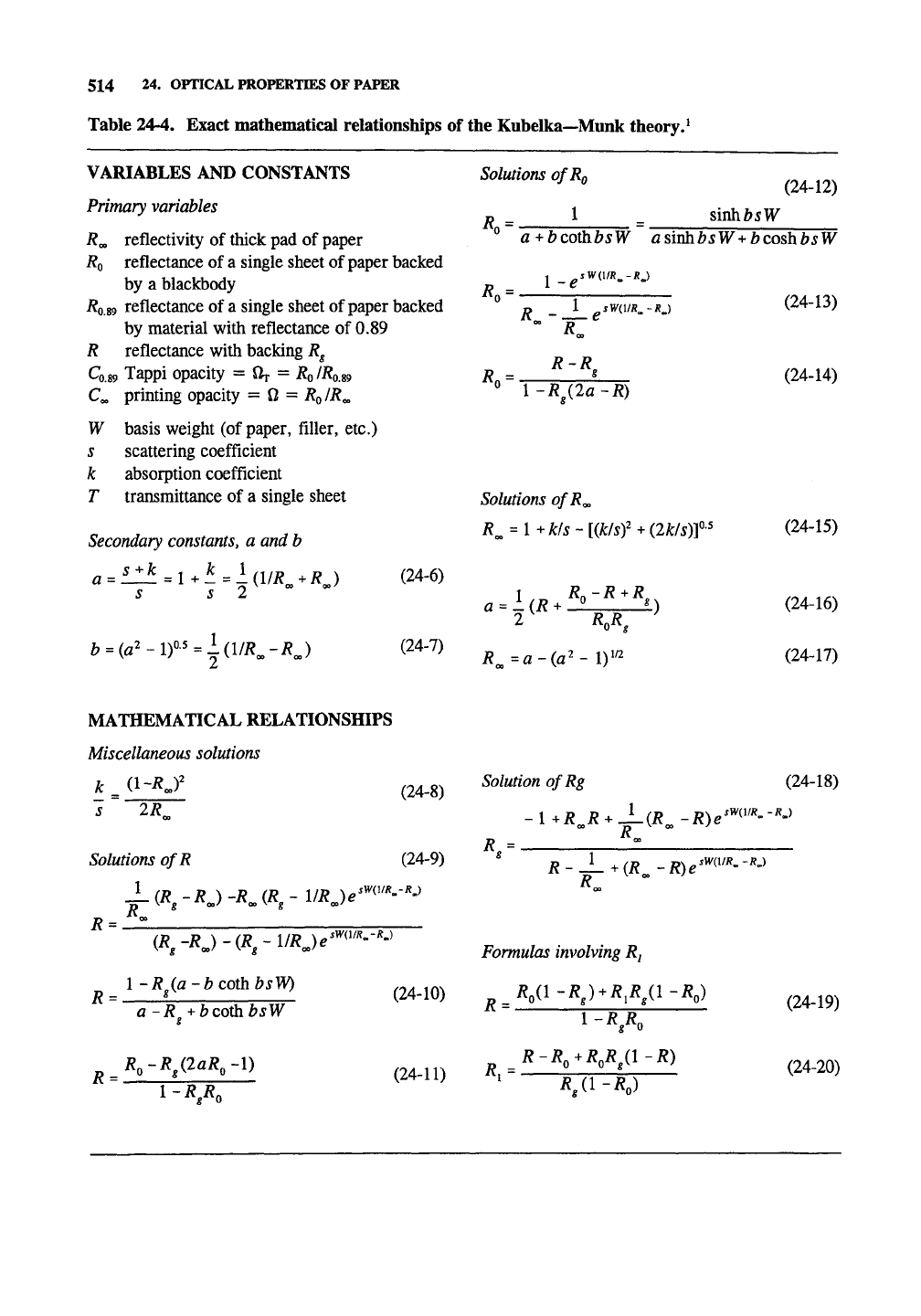
514
24.
OPTICAL PROPERTIES OF PAPER
Table 24-4. Exact mathematical relationships
of
the Kubelka—Mmik theory.^
VARIABLES AND CONSTANTS
Primary variables
R^
reflectivity
of
thick pad
of
paper
RQ
reflectance
of
a single sheet
of
paper backed
by
a
blackbody
i?o.89 reflectance
of
a single sheet
of
paper backed
by material with reflectance
of
0.89
R reflectance with backing
Rg
Q.89 Tappi opacity
= Or =
-^0/^0.89
C«,
printing opacity
= Q =
RQ
//?„
W basis weight
(of
paper, filler,
etc.)
s scattering coefficient
k absorption coefficient
T transmittance
of a
single sheet
Secondary
constants,
a
and
b
a =
— =
l^!i=^l(im^R)
s
s 2 ^ ^
b
=
(a'-ir
=
^(VR^-RJ
(24-6)
(24-7)
Solutions
O/RQ
(24-12)
R.
1
sivihbsW
R,
® a+bcoihbsW asmhbsW
+
bcoshbsW
«" l-R(2a-R)
Solutions
ofR^
R^
=
l+k/s-[(k/sf
+
i2k/s)f-^
a^iiR.^^Z^l^)
R^^a-ia^-iy
(24-13)
(24-14)
(24-15)
(24-16)
(24-17)
MATHEMATICAL RELATIONSHIPS
Miscellaneous solutions
s
2R_
(24-8)
Solutions
ofR
(24-9)
J?
J.(R^-RJ-R^(R^-l/RJe
sW(VR^-RJ
R
=
(Rg-RJ-iRg-l/RJe
1
-R^(a-bcoihbsW)
a-Rg+bco±bsW
sWiVR^-RJ
R,-RaaR^-l)
!-/?/„
(24-11)
Solution
ofRg (24-18)
R^
1^R^R^±(R^-R)e''''''''-'''
R-±^(R^-R)e'''''^'^-'''
R_
Formulas involving
R,
(24-10)
^ R,il-R^)^R,R^il-R,)
l-R,Ro
R-R,*R,R^(l-R)
/?,=.
RA^-Ro)
(24-19)
(24-20)
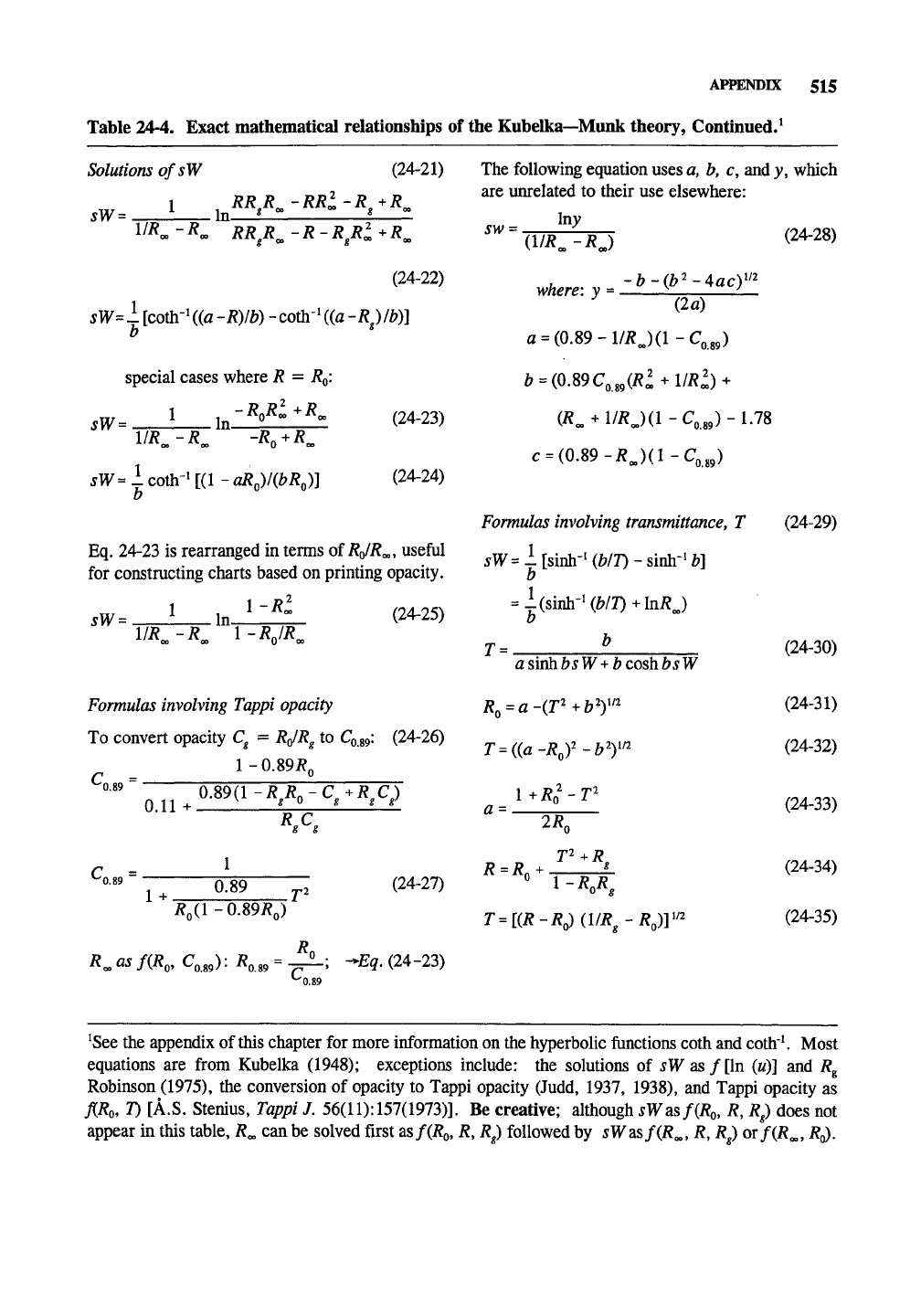
APPENDIX 515
Table 24-4. Exact mathematical relationships of the Kubelka—Munk theory, Continued.^
Solutions
ofsW
(24-21)
sW--
1 RRR-RRl-R^+R„
In
l/^oo -^oo RRR^ -R-RRl
+
R^
(24-22)
sW= 1
[coth-'
((a
-R)lb) -
coihr'
{{a
-R)
/b)]
b *
special cases where R =
RQ.
1 -R.RI+R^
sW= i In—2.J: 1
IIR^-R^ -Ro^R^
(24-23)
OO 00
sW=-
coth-' [(1 - aR^)/(bR^)] (24-24)
b
Eq. 24-23 is rearranged in terms ofRo/Ro., useful
for constructing charts based on printing opacity.
sW=
I
In-
1-R:
!//?„-/?„ 1-V^„
(24-25)
Formulas involving
Tappi opacity
To convert opacity C^ = RJR^ to Co.g,: (24-26)
1 - 0.89i?„
0.11 +
"'•'' , . 0-89 ^
(24-27)
/f„(l-0.897?„)
/f„
«„ fli /(/?„, C„3,): it„^ = » ;
->Eq.
(24-23)
'-'0.89
The following equation uses
a,
b, c, and y, which
are unrelated to their use elsewhere:
sw-
lay
(IIR^-RJ
(24-28)
where:
y
••
-b-(b^-4acy'^
(2a)
fl
=
(0.89-l/ifJ(l-C„„)
b
=
(0.&9C,^{Rl^l/Rl)*
iR„ *
l/RJH-C,
J-IJ8
c
=
(0.89-RJ(l-C,J
Formulas involving
transmittance,
T (24-29)
sW=-
[sinh-'
iJblT)
- sinh"'
b]
b
= -(sinh-'(W7)
b
T - ^
^In^J
asiviibsW+b
coshbsW
R^
=
a-(T^+by
T^iia-R.y-b'y
l+Ro-T"^
0 =
2«o
i?=/?„ + L
r=[(/?-i?j
(1//?-
R.)]'"
(24-30)
(24-31)
(24-32)
(24-33)
(24-34)
(24-35)
^See the appendix of
this
chapter for more information on the hyperbolic functions coth and coth ^ Most
equations are from Kubelka (1948); exceptions include: the solutions of sW as /[In (u)] and R^
Robinson (1975), the conversion of opacity to Tappi opacity (Judd, 1937, 1938), and Tappi opacity as
J{Ro,
T) [A.S. Stenius, Tappi J.
56(11):
157(1973)].
Be creative; although sWd&fiR^, R,
R^)
does not
appear in this table, R^ can be solved first as/(i?o, ^, R) followed by sWzs>f{R^, R,
R^)
or/(/?«.,
RQ),
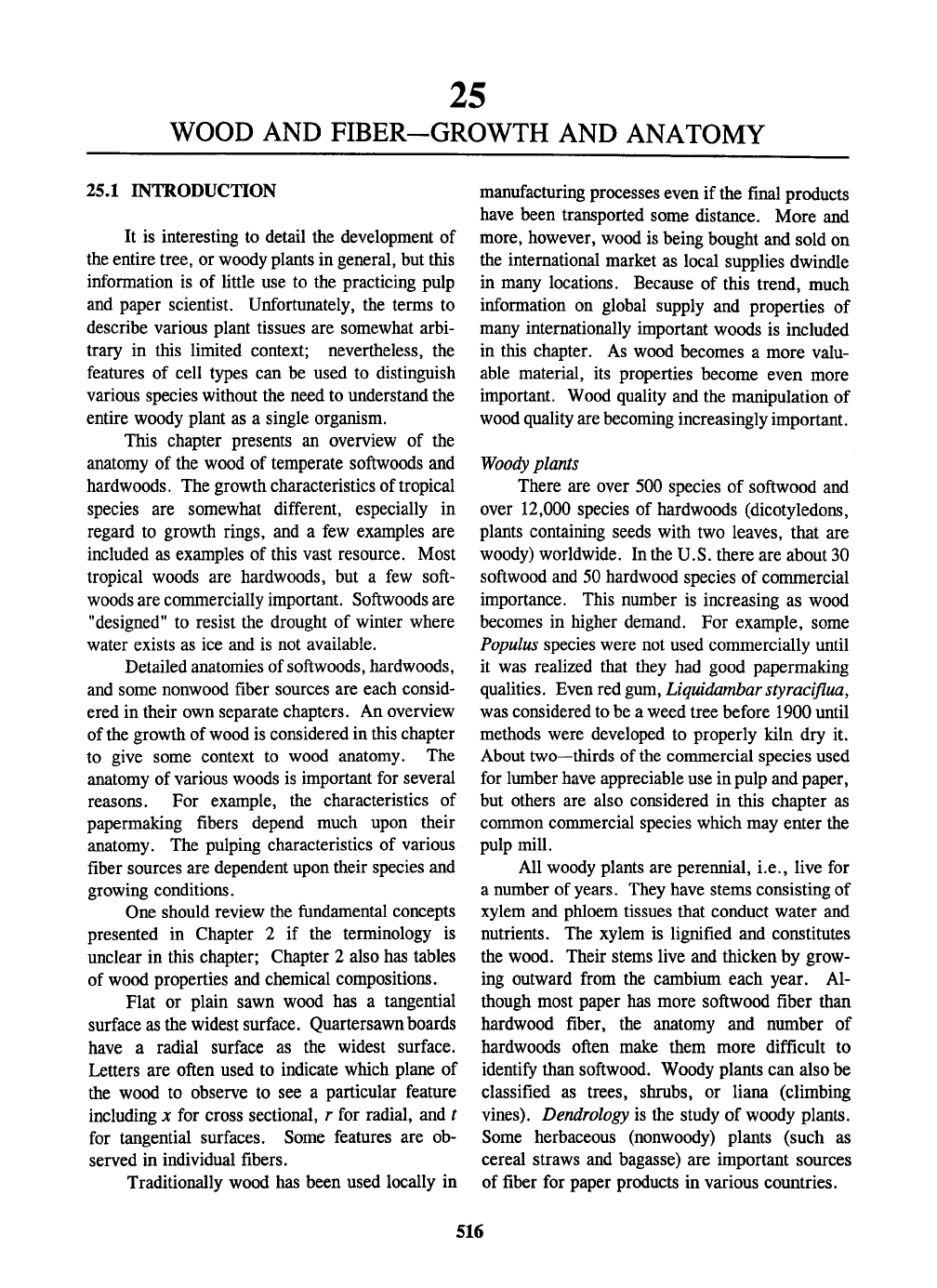
25
WOOD AND FIBER-GROWTH AND ANATOMY
25.1 INTRODUCTION
It is interesting to detail the development of
the entire tree, or woody plants in general, but this
information is of little use to the practicing pulp
and paper scientist. Unfortunately, the terms to
describe various plant tissues are somewhat arbi-
trary in this limited context; nevertheless, the
features of cell types can be used to distinguish
various species without the need to understand the
entire woody plant as a single organism.
This chapter presents an overview of the
anatomy of the wood of temperate softwoods and
hardwoods. The growth characteristics of tropical
species are somewhat different, especially in
regard to growth rings, and a few examples are
included as examples of this vast resource. Most
tropical woods are hardwoods, but a few soft-
woods are commercially important. Softwoods are
"designed" to resist the drought of winter where
water exists as ice and is not available.
Detailed anatomies of softwoods, hardwoods,
and some nonwood fiber sources are each consid-
ered in their own separate chapters. An overview
of
the
growth of wood is considered in this chapter
to give some context to wood anatomy. The
anatomy of various woods is important for several
reasons. For example, the characteristics of
papermaking fibers depend much upon their
anatomy. The pulping characteristics of various
fiber sources are dependent upon their species and
growing conditions.
One should review the fundamental concepts
presented in Chapter 2 if the terminology is
unclear in this chapter; Chapter 2 also has tables
of wood properties and chemical compositions.
Flat or plain sawn wood has a tangential
surface as the widest surface. Quartersawn boards
have a radial surface as the widest surface.
Letters are often used to indicate which plane of
the wood to observe to see a particular feature
including x for cross sectional, r for radial, and t
for tangential surfaces. Some features are ob-
served in individual fibers.
Traditionally wood has been used locally in
manufacturing processes even if the final products
have been transported some distance. More and
more, however, wood is being bought and sold on
the international market as local supplies dwindle
in many locations. Because of this trend, much
information on global supply and properties of
many internationally important woods is included
in this chapter. As wood becomes a more valu-
able material, its properties become even more
important. Wood quality and the manipulation of
wood quality are becoming increasingly important.
Woody
plants
There are over 500 species of softwood and
over 12,000 species of hardwoods (dicotyledons,
plants containing seeds with two leaves, that are
woody) worldwide. In the U.S. there are about 30
softwood and 50 hardwood species of commercial
importance. This number is increasing as wood
becomes in higher demand. For example, some
Populus species were not used commercially until
it was realized that they had good papermaking
qualities. Even red gum, Liquidambar styraciflua,
was considered to be a weed tree before 1900 until
methods were developed to properly kiln dry it.
About two—thirds of the commercial species used
for lumber have appreciable use in pulp and paper,
but others are also considered in this chapter as
common commercial species which may enter the
pulp mill.
All woody plants are perennial, i.e., live for
a number of
years.
They have stems consisting of
xylem and phloem tissues that conduct water and
nutrients. The xylem is lignified and constitutes
the wood. Their stems live and thicken by grow-
ing outward from the cambium each year. Al-
though most paper has more softwood fiber than
hardwood fiber, the anatomy and number of
hardwoods often make them more difficult to
identify than softwood. Woody plants can also be
classified as trees, shrubs, or liana (climbing
vines).
Dendrology is the study of woody plants.
Some herbaceous (nonwoody) plants (such as
cereal straws and bagasse) are important sources
of fiber for paper products in various countries.
516
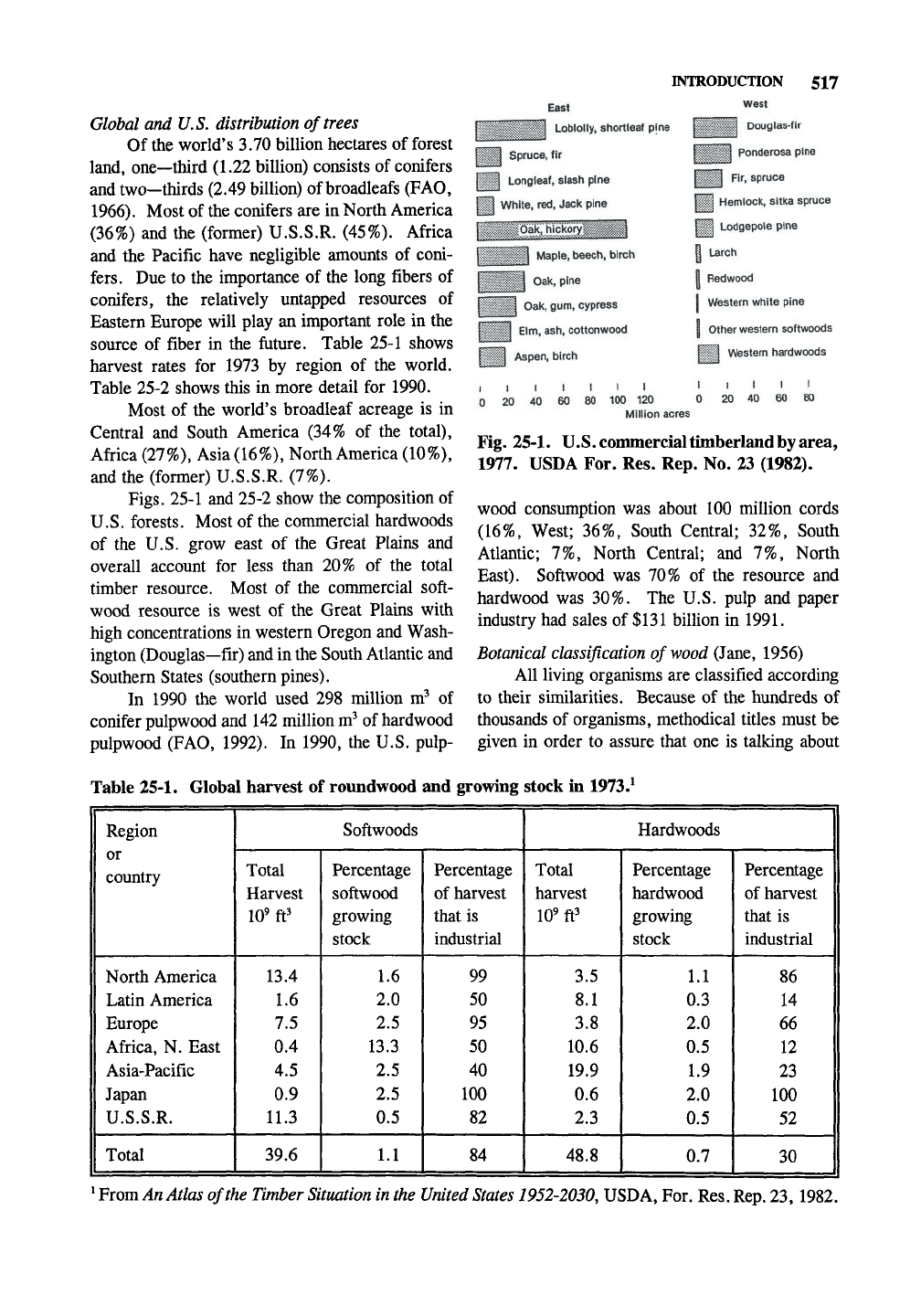
INTRODUCTION 517
Global and U.S. distribution of trees
Of the world's 3.70 billion hectares of forest
land, one—third (1.22 billion) consists of conifers
and two—thirds (2.49 billion) of broadleafs (FAO,
1966).
Most of the conifers are in North America
(36%) and the (former) U.S.S.R. (45%). Africa
and the Pacific have negligible amounts of coni-
fers.
Due to the importance of the long fibers of
conifers, the relatively untapped resources of
Eastern Europe will play an important role in the
source of fiber in the future. Table 25-1 shows
harvest rates for 1973 by region of the world.
Table 25-2 shows this in more detail for 1990.
Most of the world's broadleaf acreage is in
Central and South America (34% of the total),
Africa (27%), Asia (16%), North America (10%),
and the (former) U.S.S.R. (7%).
Figs.
25-1 and 25-2 show the composition of
U.S.
forests. Most of the commercial hardwoods
of the U.S. grow east of the Great Plains and
overall account for less than 20% of the total
timber resource. Most of the commercial soft-
wood resource is west of the Great Plains with
high concentrations in western Oregon and Wash-
ington (Douglas—fir) and in the South Atlantic and
Southern States (southern pines).
In 1990 the world used 298 million m^ of
conifer pulpwood and 142 million
m^
of hardwood
pulpwood (FAO, 1992). In 1990, the U.S. pulp-
West
rjf^<^\ S^ Loblolly, shortleaf pine [^yfvg^ Douglas-fir
Y^M Spruce, fir
[ni Longleaf. slash pine
Fl White, red, Jack pine
rr>sEy.
n!j^ ponderosa pine
\f^'t\
Fir, spruce
PI Hemlock, sItka spmce
pi Lodgepole pine
I Urch
I Redwood
I Western white pine
I Other western softwoods
P2 Western hardwoods
till
20 40 60 80
I Maple, t>eech, birch
\^t:^ oak, pine
Oak, gum, cypress
Elm,
ash, cottonwood
Y^'^l Aspen, birch
I I I I t I I I
0 20 40 60 80 100 120 0
Million acres
Fig. 25-1. U.S.coimnercialtimberlandbyarea,
1977. USDA For. Res. Rep. No. 23 (1982).
wood consumption was about 100 million cords
(16%,
West; 36%, South Central; 32%, South
Atlantic; 7%, North Central; and 7%, North
East).
Softwood was 70% of the resource and
hardwood was 30%. The U.S. pulp and paper
industry had sales of
$131
billion in 1991.
Botanical
classification
of
wood
(Jane, 1956)
All living organisms are classified according
to their similarities. Because of the hundreds of
thousands of organisms, methodical titles must be
given in order to assure that one is talking about
Table 25-1. Global harvest of roundwood and growing stock in 1973.^
Region
or
country
North America
Latin America
Europe
Africa, N. East
Asia-Pacific
Japan
1
U.S.S.R.
Total
Softwoods
Total
Harvest
10'ft'
13.4
1.6
7.5
0.4
4.5
0.9
11.3
39.6
Percentage
softwood
growing
stock
1.6
2.0
2.5
13.3
2.5
2.5
0.5
1.1
Percentage
of harvest
that is
industrial
99
50
95
50
40
100
82
84
Hardwoods
Total
harvest
10'ft'
3.5
8.1
3.8
10.6
19.9
0.6
2.3
48.8
Percentage
hardwood
growing
stock
1.1
0.3
2.0
0.5
1.9
2.0
0.5
0.7
Percentage
of harvest
that is
industrial
86
14
66
12
23
100
52
1
30
1
^
From An Atlas of the Timber
Situation
in the
United States
1952-2030,
USDA, For. Res. Rep, 23, 1982.
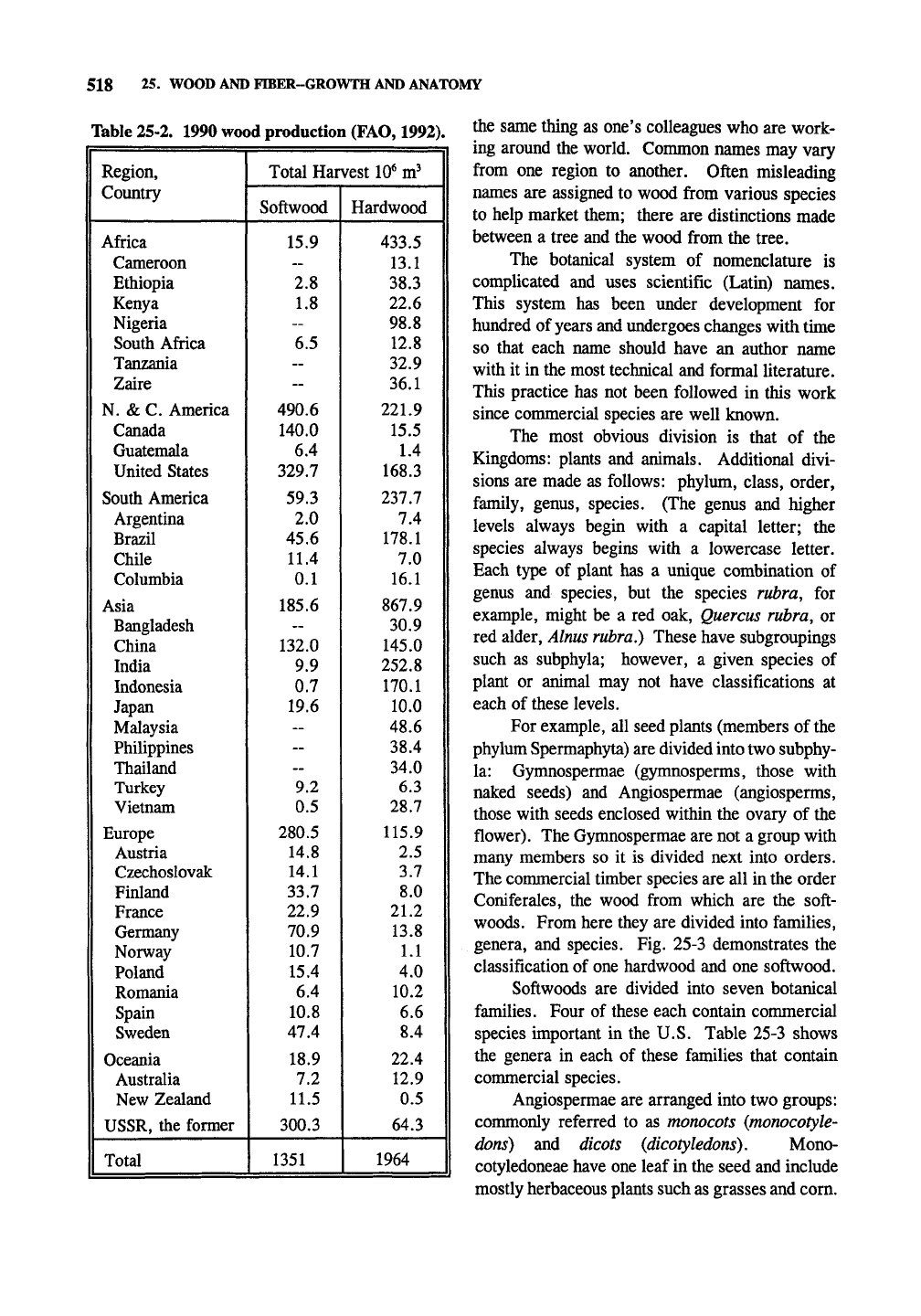
518 25. WOOD AND FIBER--GROWTH AND ANATOMY
Table 25-2. 1990 wood production (FAO, 1992).
Region,
Country
Africa
Cameroon
Ethiopia
Kenya
Nigeria
South Africa
Tanzania
Zaire
N.
& C. America
Canada
Guatemala
United States
South America
Argentina
Brazil
Chile
Columbia
Asia
Bangladesh
China
India
Indonesia '
Japan
Malaysia
Philippines '
Thailand
Turkey
Vietnam
Europe
Austria
Czechoslovak
Finland
France
Germany
Norway
Poland
Romania
Spain
Sweden
Oceania
Australia
New Zealand
1 USSR, the former
I Total
Total Harvest
10^
m^
||
Softwood
15.9
""
2.8
1.8
-
6.5
~
-
490.6
140.0
6.4
329.7
59.3
2.0 '
45.6
11.4
0.1
185.6 1
1
132.0
9.9
0.7
19.6
-
-
—
9.2
0.5
280.5
14.8
14.1
33.7
22.9
70.9
10.7
15.4
6.4
10.8
47.4
18.9
7.2
11.5
300.3
1 1351
Hardwood [|
433.5
13.1
38.3
22.6
98.8
12.8
32.9
36.1
221.9
15.5
1.4
168.3
237.7
7.4
178.1
7.0
16.1
867.9
30,9
145.0
252.8
170.1
10.0
48.6
38.4
34.0
6.3
28.7
115.9
2.5
3.7
8.0
21.2
13.8
1.1
4.0
10.2
6.6
8.4
22.4
12.9
0.5
64.3
1964
the same thing as one's colleagues who are work-
ing around the world. Common names may vary
from one region to another. Often misleading
names are assigned to wood from various species
to help market them; there are distinctions made
between a tree and the wood from the tree.
The botanical system of nomenclature is
complicated and uses scientific (Latin) names.
This system has been under development for
hundred of
years
and undergoes changes with time
so that each name should have an author name
with it in the most technical and formal literature.
This practice has not been followed in this work
since commercial species are well known.
The most obvious division is that of the
Kingdoms: plants and animals. Additional divi-
sions are made as follows: phylum, class, order,
family, genus, species. (The genus and higher
levels always begin with a capital letter; the
species always begins with a lowercase letter.
Each type of plant has a unique combination of
genus and species, but the species rubra, for
example, might be a red oak, Quercus rubra, or
red alder,
Alnus
rubra.) These have subgroupings
such as subphyla; however, a given species of
plant or animal may not have classifications at
each of these levels.
For example, all seed plants (members of
the
phylum Spermaphyta) are divided
into
two subphy-
la:
Gymnospermae (gymnosperms, those with
naked seeds) and Angiospermae (angiosperms,
those with seeds enclosed within the ovary of the
flower). The Gymnospermae are not a group with
many members so it is divided next into orders.
The commercial timber species are all in the order
Coniferales, the wood from which are the soft-
woods. From here they are divided into families,
genera, and species. Fig. 25-3 demonstrates the
classification of one hardwood and one softwood.
Softwoods are divided into seven botanical
families. Four of these each contain commercial
species important in the U.S. Table 25-3 shows
the genera in each of these families that contain
commercial species.
Angiospermae are arranged into two groups:
conmionly referred to as monocots (monocotyle-
dons) and dicots (dicotyledons). Mono-
cotyledoneae have one leaf in the seed and include
mostly herbaceous plants such
as
grasses and corn.
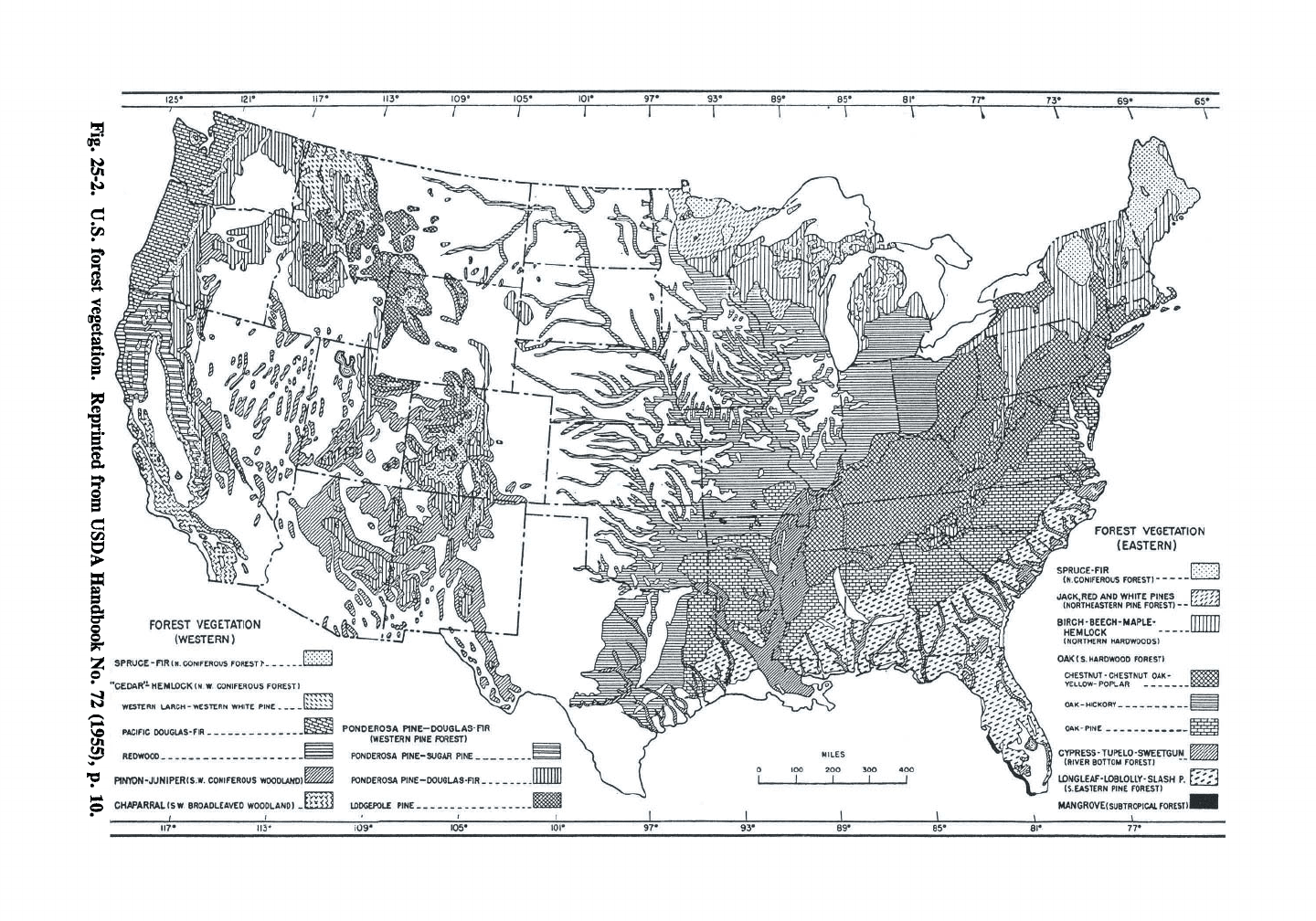
Fig. 25-2. U.S. forest vegetation. Reprinted from USDA Handbook No. 72 (1955), p. 10.
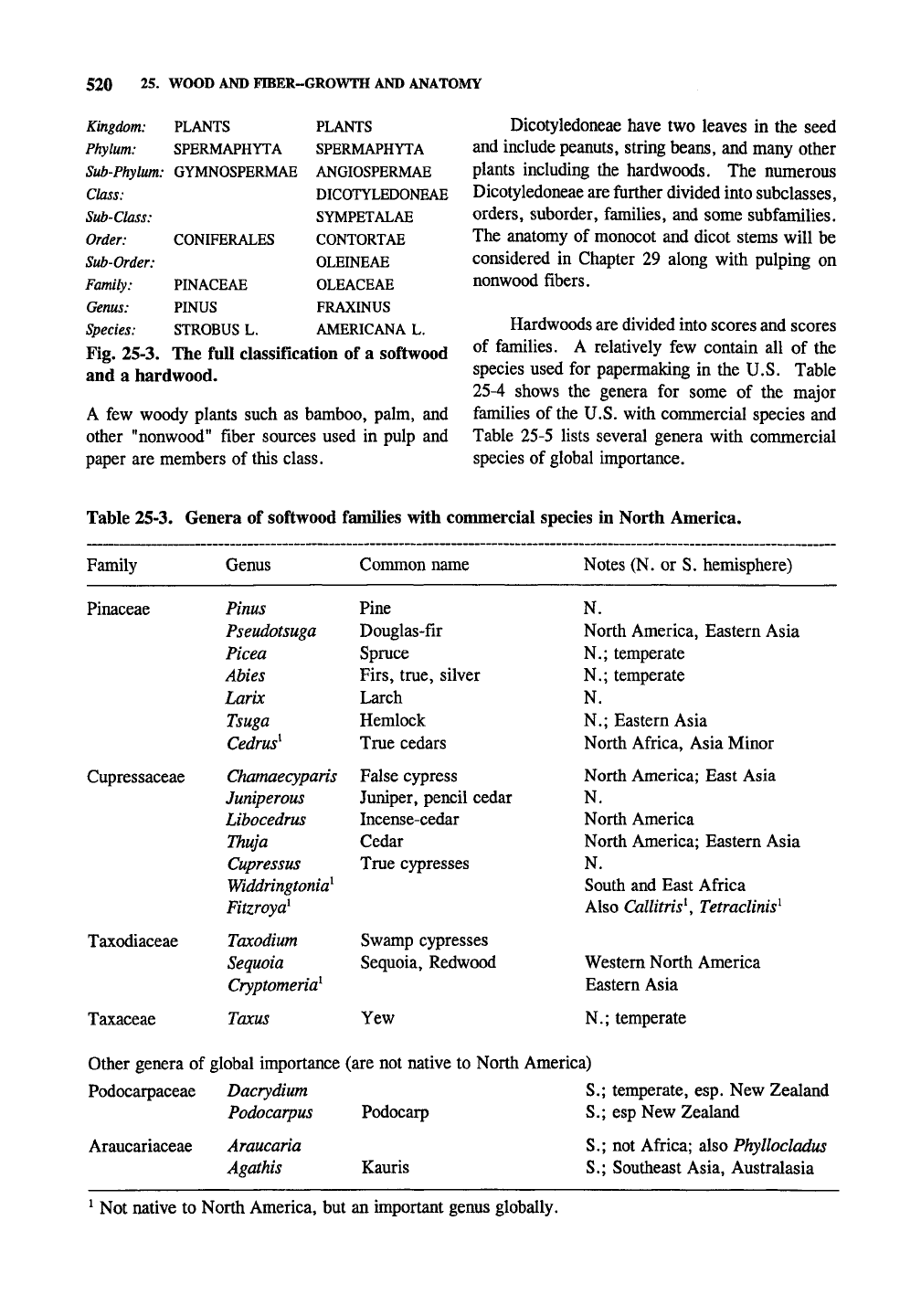
520 25. WOOD AND FIBER-GROWTH AND ANATOMY
Kingdom:
Phylum:
Sub-Phylum:
Class:
Sub-Class:
Order:
Sub-Order:
Family:
Genus:
Species:
Fig. 25-3.
PLANTS
SPERMAPHYTA
GYMNOSPERMAE
CONIFERALES
PINACEAE
PINUS
STROBUS L.
PLANTS
SPERMAPHYTA
ANGIOSPERMAE
DICOTYLEDONEAE
SYMPETALAE
CONTORTAE
OLEINEAE
OLEACEAE
FRAXINUS
AMERICANA L.
The full classification of a softwood
and a hardwood.
A few woody plants such as bamboo, palm, and
other "nonwood" fiber sources used in pulp and
paper are members of this class.
Dicotyledoneae have two leaves in the seed
and include peanuts, string beans, and many other
plants including the hardwoods. The numerous
Dicotyledoneae are further divided into subclasses,
orders, suborder, families, and some subfamilies.
The anatomy of monocot and dicot stems will be
considered in Chapter 29 along with pulping on
nonwood fibers.
Hardwoods are divided into scores and scores
of families. A relatively few contain all of the
species used for papermaking in the U.S. Table
25-4 shows the genera for some of the major
families of the U.S. with commercial species and
Table 25-5 lists several genera with commercial
species of global importance.
Table 25-3. Genera of softwood families with commercial species in North America.
Family
Pinaceae
Cupressaceae
Taxodiaceae
Taxaceae
Genus
Pinus
Pseudotsuga
Picea
Abies
Larix
Tsuga
Cedrus^
Chamaecyparis
Juniperous
Libocedrus
Thuja
Cupressus
Widdringtonia^
Fitzroya}
Taxodium
Sequoia
Cryptomeria^
Taxus
Common name
Pine
Douglas-fir
Spruce
Firs,
true, silver
Larch
Hemlock
True cedars
False cypress
Juniper, pencil cedar
Incense-cedar
Cedar
True cypresses
Swamp cypresses
Sequoia, Redwood
Yew
Notes (N. or S. hemisphere)
N.
North America, Eastern Asia
N.;
temperate
N.;
temperate
N.
N.;
Eastern Asia
North Africa, Asia Minor
North America; East Asia
N.
North America
North America; Eastern Asia
N.
South and East Africa
Also Callitris\
Tetraclinis^
Western North America
Eastern Asia
N.;
temperate
Other genera of global importance (are not native to North America)
Podocarpaceae
Araucariaceae
Dacrydium
Podocarpus
Araucaria
Agathis
Podocarp
Kauris
S.; temperate, esp. New Zealand
S.; esp New Zealand
S.; not Africa; also Phyllocladus
S.; Southeast Asia, Australasia
^
Not native to North America, but an important genus globally.
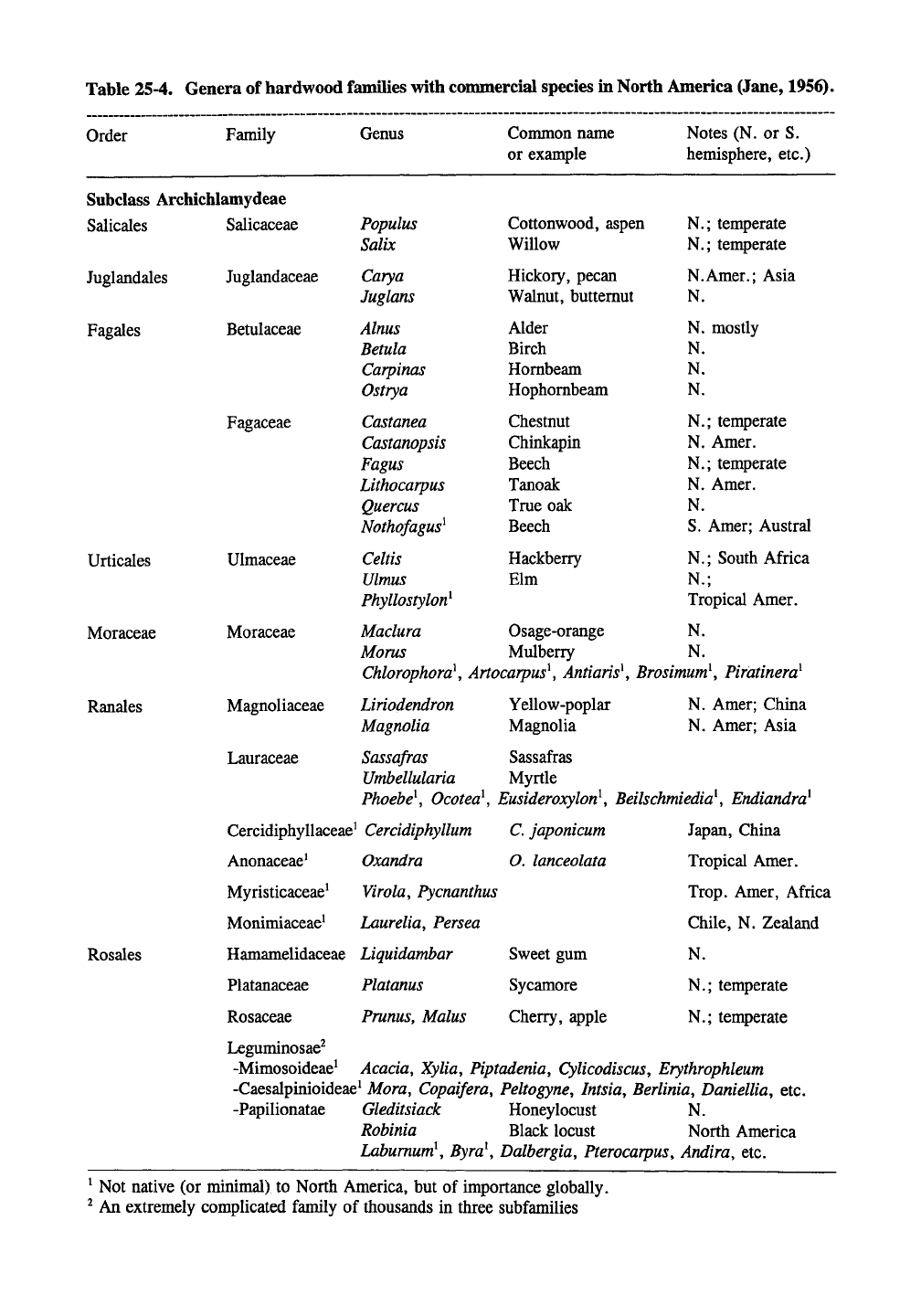
Table 25-4. Genera of hardwood families with commercial species in North America (Jane, 1956).
Order
Family
Subclass Archichlamydeae
Salicales
Juglandales
Fagales
Urticales
Moraceae
Ranales
Salicaceae
Juglandaceae
Betulaceae
Fagaceae
Ulmaceae
Moraceae
Magnoliaceae
Lauraceae
Genus
Populus
Salix
Carya
Juglans
Alnus
Betula
Carpinas
Ostrya
Castanea
Castanopsis
Fagus
Lithocarpus
Quercus
Nothofagus^
Celtis
Ulmus
Phyllostylon^
Madura
Moms
Chlorophora\
Liriodendron
Magnolia
Sassafras
Common name
or example
Cottonwood, aspen
Willow
Hickory, pecan
Walnut, butternut
Alder
Birch
Hornbeam
Hophombeam
Chestnut
Chinkapin
Beech
Tanoak
True oak
Beech
Hackberry
Elm
Notes (N. or S.
hemisphere, etc.)
N.;
temperate
N.;
temperate
N.Amer.; Asia
N.
N.
mostly
N.
N.
N.
N.;
temperate
N.
Amer.
N.;
temperate
N.
Amer.
N.
S. Amer; Austral
N.;
South Africa
N.;
Tropical Amer.
Osage-orange N.
Mulberry N.
Artocarpus\ Antiaris\ Brosimum\
Piratinera^
Yellow-poplar
Magnolia
Sassafras
N.
Amer; China
N.
Amer; Asia
Umbellularia Myrtle
Phoebe^,
Ocotea^,
Eusideroxylon\ Beilschmiedia\
Endiandra^
Cercidiphyllaceae^
Cercidiphyllum
C.
japonicum
Anonaceae^ Oxandra O. lanceolata
Myristicaceae^ Virola,
Pycnanthus
Monimiaceae^ Laurelia, Persea
Rosales Hamamelidaceae Liquidambar Sweet gum
Platanaceae Platanus Sycamore
Rosaceae Prunus, Malus Cherry, apple
Leguminosae^
-Mimosoideae^ Acacia, Xylia, Piptadenia,
Cylicodiscus,
Erythrophleum
-Caesalpinioideae^ Mora,
Copaifera,
Peltogyne, Intsia,
Berlinia,
Daniellia, etc
-Papilionatae Gleditsiack Honeylocust N.
Robinia Black locust North America
Labumum\ Byra\ Dalbergia,
Pterocarpus,
Andira, etc.
^
Not native (or minimal) to North America, but of importance globally.
^ An extremely complicated family of thousands in three subfamilies
Japan, China
Tropical Amer.
Trop.
Amer, Africa
Chile, N. Zealand
N.
N.;
temperate
N.;
temperate
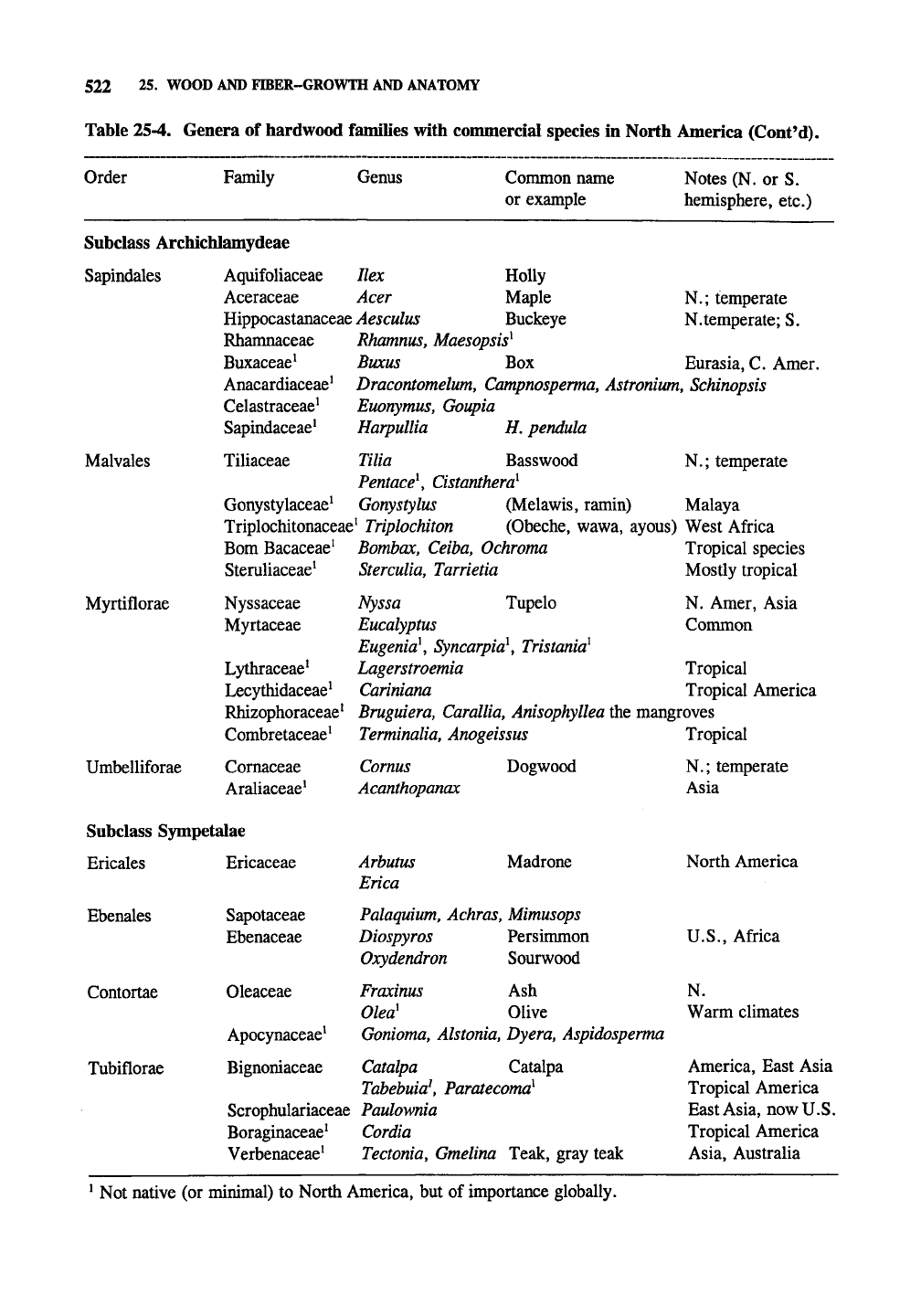
522 25. WOOD AND FIBER--GROWTH AND ANATOMY
Table 25-4. Genera of hardwood families with commercial species in North America (Cont'd).
Order
Family
Genus
Common name
or example
Notes (N. or S.
hemisphere, etc.)
Subclass Archichlamydeae
Sapindales
Malvales
Myrtiflorae
Umbelliforae
N.;
temperate
N.temperate; S.
Aquifoliaceae Ilex Holly
Aceraceae Acer Maple
Hippocastanaceae Aesculus Buckeye
Rhamnaceae
Rhamnus,
Maesopsis^
Bwcus Box Eurasia, C. Amer.
Dracontomelum,
Campnosperma,
Astronium,
Schinopsis
Euonymus,
Goupia
Harpullia H, pendula
Buxaceae*
Anacardiaceae
Celastraceae^
Sapindaceae^
Tiliaceae
N.;
temperate
Tilia Basswood
Pentace\
Cistanthera}
Gonystylaceae^ Gonystylus (Melawis, ramin) Malaya
Triplochitonaceae^ Triplochiton (Obeche, wawa, ayous) West Africa
Bom Bacaceae^ Bombax, Ceiba, Ochroma Tropical species
Steruliaceae^ Sterculia, Tarrietia Mostly tropical
Nyssaceae
Myrtaceae
Lythraceae^
Lecythidaceae^
Rhizophoraceae^
Combretaceae^
Cornaceae
Araliaceae^
Tupelo
N.
Amer, Asia
Common
Nyssa
Eucalyptus
Eugenia\ Syncarpia\
Tristania}
Lagerstroemia Tropical
Cariniana Tropical America
Bruguiera, Carallia,
Anisophyllea
the mangroves
Terminalia,
Anogeissus
Tropical
Cornus
Acanthopanax
Dogwood
N.;
temperate
Asia
Subclass Sympetalae
Ericales Ericaceae
Ebenales
Contortae
Tubiflorae
Sapotaceae
Ebenaceae
Oleaceae
Apocynaceae^
Bignoniaceae
Arbutus
Erica
Madrone
Palaquium,
Achras,
Mimusops
Diospyros Persimmon
Oxydendron Sourwood
Fraxinus Ash
Olea^ Olive
Gonioma,
Alstonia,
Dyera, Aspidosperma
Catalpa Catalpa
Tabebuia\
Paratecoma^
Scrophulariaceae Paulownia
Boraginaceae^ Cordia
Verbenaceae^ Tectonia, Gmelina Teak, gray teak
North America
U.S.,
Africa
N.
Warm climates
America, East Asia
Tropical America
East Asia, now U.S.
Tropical America
Asia, Australia
^
Not native (or minimal) to North America, but of importance globally.
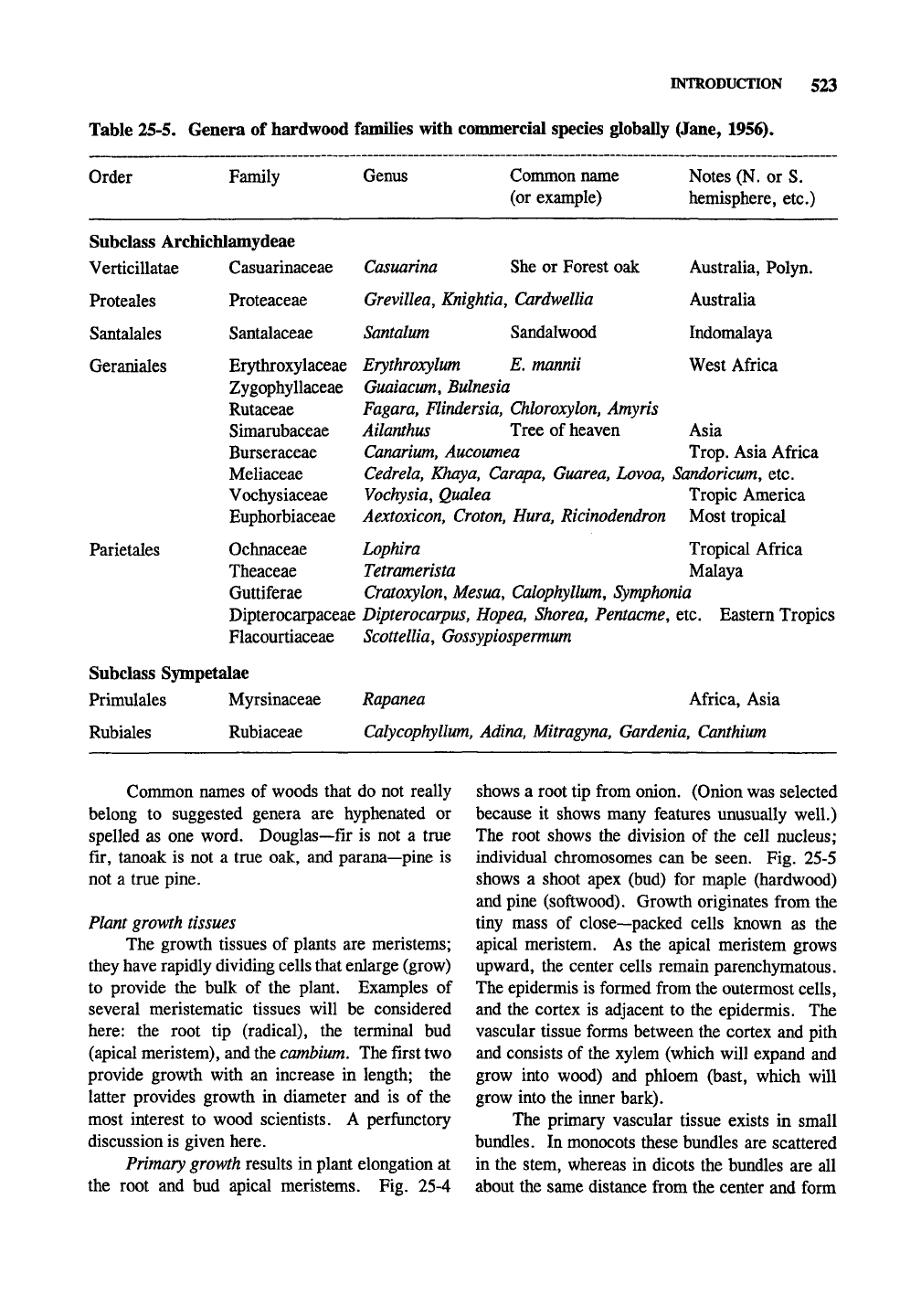
INTRODUCTION 523
Table 25-5. Genera of hardwood families with commercial species globally (Jane, 1956) •
Order
Family
Genus
Common name
(or example)
Notes (N. or S.
hemisphere, etc.)
Subclass Archichlamydeae
Verticillatae Casuarinaceae
Proteales Proteaceae
Santalales Santalaceae
Geraniales Erythroxylaceae
Zygophyllaceae
Rutaceae
Simarubaceae
Burseraceae
Meliaceae
Vochysiaceae
Euphorbiaceae
Parietales Ochnaceae
Theaceae
Guttiferae
Dipterocarpaceae
Flacourtiaceae
Subclass Sympetalae
Primulales Myrsinaceae
Rubiales Rubiaceae
Casuarina She or Forest oak Australia, Polyn.
Grevillea,
Knightia,
Cardwellia Australia
Santalum
Sandalwood
Erythroxylum E,
mannii
Guaiacum,
Bulnesia
Fagara,
Flindersia,
Chloroxylon,
Amyris
Ailanthus Tree of heaven
Canarium,
Aucownea
Cedrela, Khaya, Carapa,
Guarea,
Lovoa,
Vochysia,
Qualea
Aextoxicon,
Croton,
Hura,
Ricinodendron
Indomalaya
West Africa
Asia
Trop.
Asia Africa
Sandoricum,
etc.
Tropic America
Most tropical
Lophira Tropical Africa
Tetramerista Malaya
Cratoxylon,
Mesua,
Calophyllum,
Symphonia
Dipterocarpus, Hopea,
Shorea,
Pentacme, etc. Eastern Tropics
Scottellia,
Gossypiospermum
Rapanea Africa, Asia
Calycophyllum,
Adina,
Mitragyna,
Gardenia, Canthiwn
Common names of woods that do not really
belong to suggested genera are hyphenated or
spelled as one word. Douglas—fir is not a true
fir, tanoak is not a true oak, and parana—pine is
not a true pine.
Plant
growth
tissues
The growth tissues of plants are meristems;
they have rapidly dividing cells that enlarge (grow)
to provide the bulk of the plant. Examples of
several meristematic tissues will be considered
here:
the root tip (radical), the terminal bud
(apical meristem), and the
cambium.
The first two
provide growth with an increase in length; the
latter provides growth in diameter and is of the
most interest to wood scientists. A perfunctory
discussion is given here.
Primary growth results in plant elongation at
the root and bud apical meristems. Fig. 25-4
shows a root tip from onion. (Onion was selected
because it shows many features unusually well.)
The root shows the division of the cell nucleus;
individual chromosomes can be seen. Fig. 25-5
shows a shoot apex (bud) for maple (hardwood)
and pine (softwood). Growth originates from the
tiny mass of close—packed cells known as the
apical meristem. As the apical meristem grows
upward, the center cells remain parenchymatous.
The epidermis is formed from the outermost cells,
and the cortex is adjacent to the epidermis. The
vascular tissue forms between the cortex and pith
and consists of the xylem (which will expand and
grow into wood) and phloem (bast, which will
grow into the inner bark).
The primary vascular tissue exists in small
bundles. In monocots these bundles are scattered
in the stem, whereas in dicots the bundles are all
about the same distance from the center and form
